A business is nothing without a productive team — but with a fluctuating workforce with varying degrees of digital proficiency between younger and older workers, employers are finding that the traditional structure of workplace relationships and mentorship is not cutting it.
That's not to say that mentorship has become obsolete: 87% of mentors and mentees feel empowered by their relationships and have developed greater confidence, according to a recent study from Moving Ahead, a platform dedicated to promoting equitable workplaces. But the growing trend of "reverse mentoring" may bring new value to the equation.
"As a mentor or mentee, there's always something to learn and something to give," says Sara Rahmani, vice president of people experience and DEI at software company Chronus. "The nice thing about reverse mentoring is that it really puts a concentration on what someone — who might normally be a mentee in a traditional format — has to teach someone older or more senior."
Reverse mentorship refers to a relationship in which
Read more:
"I realized to continue doing my job at an impactful level I needed to learn more about Excel and data management — spreadsheets, data and beyond was just something I'd never really had to learn before or manage at a more granular level," she says. "I've partnered with one of my [younger] colleagues to help build that skill set so that I can be more precise and data-focused in my job. It's not always an easy thing to admit you need help or additional guidance, but it has been really rewarding to not only learn from another person, but vocalize my questions and learnings along the way."
Gen Z is expected to account for half of the workforce over the course of the next ten years, according to data from Concordia St. Paul University. And with them they're bringing an entirely fresh perspective on work and life that could benefit the employees that came before them. It may initially be difficult to redefine the power dynamic between junior and senior employees, the payoff is worth it.
In 2021, pharmaceutical group Johnson & Johnson implemented a Reverse Mentoring initiative to drive the adoption of tech inside of their organization, according to a recent case study from LinkedIn. As a result, 88% of their senior leadership team described the initiative as a "positive and unique personal experience." The same year, cosmetics company Estee Lauder officially launched their reverse mentorship program and has reported an overwhelmingly positive outcome, especially for their younger employees.
Read more:
"The fact that companies are really placing an emphasis on valuing these younger voices to help educate and inform big strategy decisions is important," says Meagan Loyst, an associate at venture capital firm Lerer Hippeau, recently told EBN. The 25-year-old is also the founder of Gen Z VC, an online network of young and aspiring venture capitalists. As she's grown the community, she's seen attitudes about generational value at work evolve. "It's important for retention to hear younger voices and encourage that exchange of information between the youngest people in an organization and the most senior talent."
Additionally,
When Elizabeth Derby's former employer implemented a reverse mentorship program in 2013, they noticed that a lot of the junior employees were also from historically underrepresented groups. Derby is now managing director at HR consulting and advisory firm Kincentric, where she continues to encourage and boast about the DEI benefits of non-traditional mentorship set ups.
Read more:
"We deliberately wanted to do two things. First, our aim was to ensure that the senior professionals gained insight into the challenges faced by early-career employees, particularly those from underrepresented groups," Derby says. "Research shows that employees from underrepresented groups don't get as much mentoring or sponsorship in the workplace. Secondly, we wanted the junior professionals to benefit from the advice and career guidance of the senior professionals. This two-way relationship and insight sharing was a win-win with the senior professional often feeling they gained more than they gave."
The primary challenge in reverse mentorship dynamics won't be pairing up the two demographics, but doing it in a way where younger employees aren't burdened with teaching older generations to embrace diversity, according to Rahmani. The relationship between young mentors and older mentees must be reciprocal.
"With the right intent, training and formal reverse mentoring execution, this format can enable candid conversations around the state of the workplace and areas for improvement between employees who may never have come into contact otherwise," she says. "This can build better belonging for employees, offer pathways for change and enable employees to believe in a shared mission while committing to working on a shared future."






